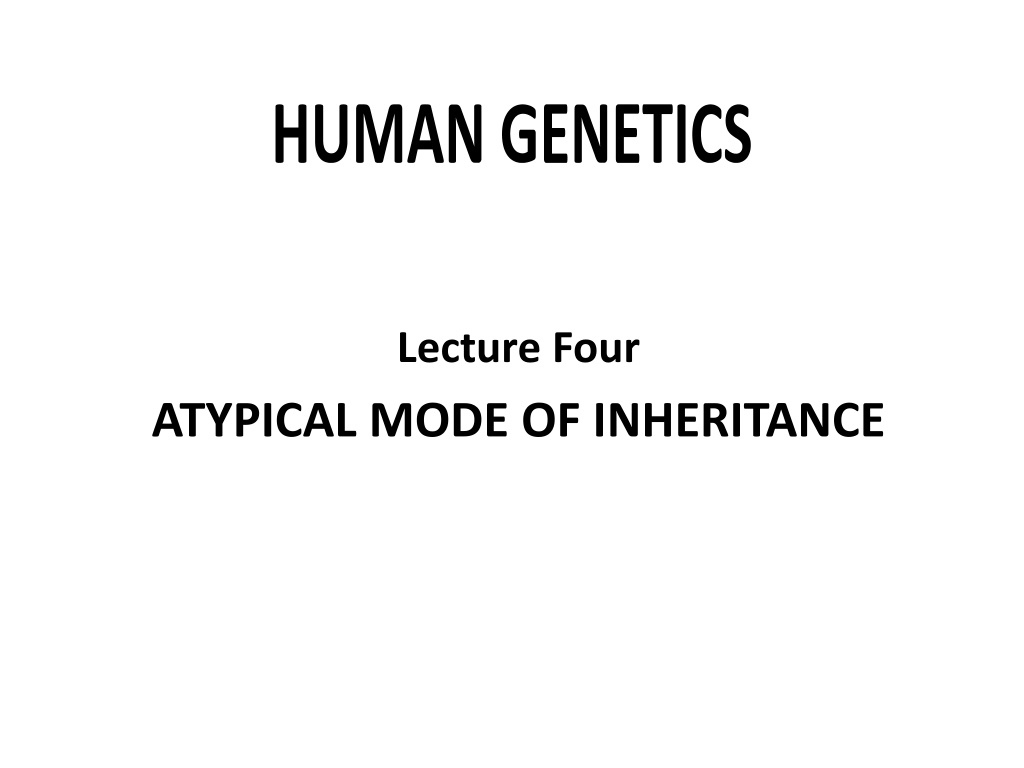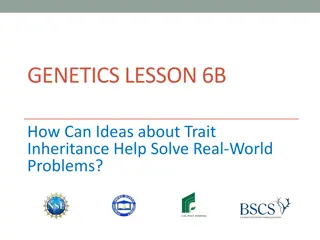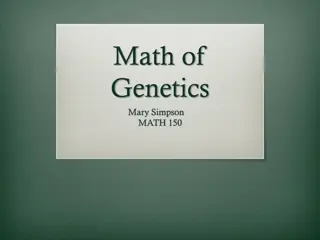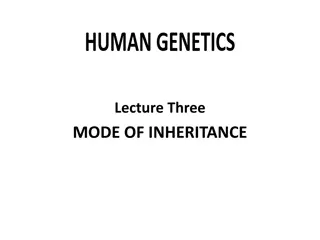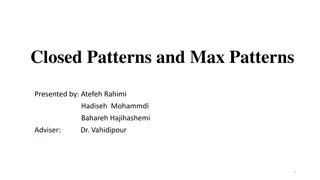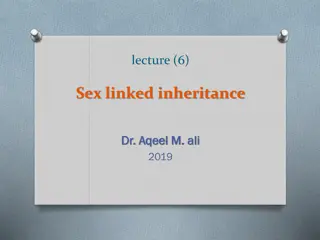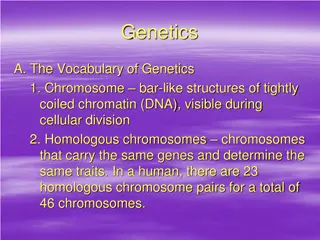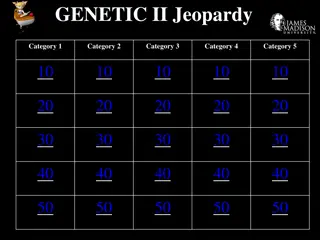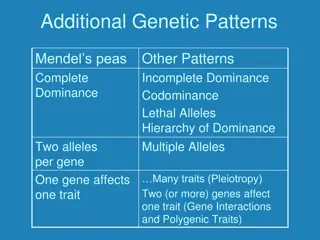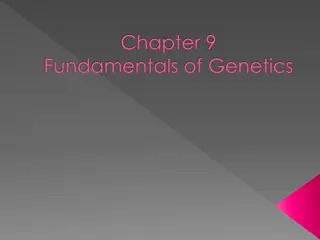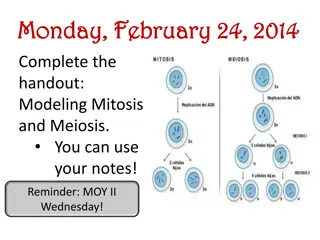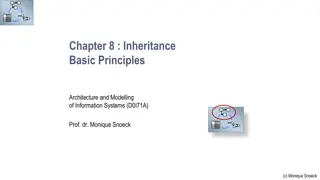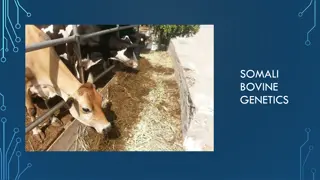Understanding Atypical Patterns of Inheritance in Genetics
Explore atypical modes of inheritance such as codominant traits, pseudodominant inheritance, mitochondrial inheritance, anticipation, pleiotropy, variable expressivity, heterogeneity, new mutation, and complex traits in genetics. Learn about codominance, pseudodominance, and atypical presentation of single-gene disorders, including maternal inheritance of mitochondrial mutations. Gain insights into unusual inheritance patterns like genomic imprinting and mosaicism.
Download Presentation

Please find below an Image/Link to download the presentation.
The content on the website is provided AS IS for your information and personal use only. It may not be sold, licensed, or shared on other websites without obtaining consent from the author. Download presentation by click this link. If you encounter any issues during the download, it is possible that the publisher has removed the file from their server.
E N D
Presentation Transcript
Lecture Four ATYPICAL MODE OF INHERITANCE
Objectives: By the end of this lecture, students should understand atypical patterns of inheritance with special emphasis on: 1. Codominant traits 2. Pseudodominant inheritance 3. The mitochondrial inheritance 4. Anticipation 5. Pleiotropy 6. Variable expressivity 7. Heterogeneity 8. New mutation 9. Complex trait: multifactorial/Polygenic
Codominant traits - This pattern occurs when the heterozygote expresses both alleles simultaneously without forming an intermediate phenotype. For example, in blood typing, an individual carrying the A and B alleles has an AB blood type. - most genes exist in multiple alleles
Possible genotypes, phenotypes & gametes formed from the four alleles: A1, A2, B, & O at the ABO locus Genotype A1A1 A2A2 BB OO A1A2 A1B A1O A2B A2O BO Phenotype A1 A2 B O A1 A1B A1 A2B A2 B Gamete A1 A2 B O A1 orA2 A1 orB A1 orO A2 orB A2 orO BorO
PSEUDODOMINANT INHERITANCE is the situation in which the inheritance of a recessive trait mimics a dominant pattern.
Pedigree: Pseudodominant inheritance A woman homozygous for an autosomal recessive disorder whose husband is heterozygous for the same disorder. Their children have a 1 in 2 (50%) chance of being affected (homozygous ) i.e. pseudodominant
Atypical inheritance of single- gene disorders What are the situations in which the inheritance of single-gene disorders diverges from typical mendelian patterns?
Maternal inheritance of mitochondrial mutations Anticipation Atypical presentation for Autosomal Dominant defects: Pleotropy Variable expressivity Reduced penetrance New mutation Unusual inheritance patterns due to Genomic Imprinting Mosaicism: Somatic mosaicism Germline mosaicism
MITOCHONDRIAL INHERITANCE Each cell contains thousands of copies of mitochondrial DNA with more being found in cells having high energy requirement (e.g. brain & muscle) Mitochondria (& their DNA) are inherited from the mother (through ova) mtDNA is a small circular double-stranded molecule containing 37 genes (coding for rRNA, tRNA, and some of the proteins of the mitochondrial electron transport chain)
Homoplasmy vs. Heteroplasmy Homoplasmy = normally the mtDNA from different mitochondria is almost identical. Heteroplasmy = the presence of two populations of mtDNA in a cell; the normal mtDNA & the mutant mtDNA. The proportion of mutant mtDNA varies between cells & tissues a range of phenotypic severity in mitochondrial inheritance.
Mitochondrial inheritance - Mitochondria and their genes are passed only from the mother. - Cells have many mitochondria. If an oocyte is heteroplasmic, differing numbers of copies of a mitochondrial mutation may be transmitted. - The phenotype reflects the proportion of mitochondria bearing the mutation. - Typical Example of Mitochondrial Disorders Leber hereditary optic neuropathy (LHON) Rapid Optic nerve death blindness in young adult life
Mitochondrial inheritance Males do not transmit the disease as the cytoplasm is inherited only from the mother since the mitochondria are present in the cytoplasm
ANTICIPATION A pattern of inheritance in which individuals in the most recent generations of a pedigree develop a disease at an earlier age or with greater severity than do those in earlier generation. The reason might be the gradual expansion of trinucleotide repeat polymorphisms within or near a coding gene Examples of diseases showing anticipation: Huntington disease Myotonic dystrophy
PLEIOTROPY - A single-gene disorder with many symptoms, or a gene that controls several functions or has more than one effect, is termed pleiotropic. - Causes autosomal dominant disorders - Example: tuberous sclerosis affected individuals can present with either learning difficulties, Epilepsy, facial rashes , or all features
VARIABLE EXPRESSIVITY The clinical features in autosomal dominant disorders can show striking variation from person to person, even in the same family. Example: Autosomal dominant polycystic kidney disease others have just a few renal cysts that do not significantly affect renal function some affected individuals develop renal failure in early adulthood
REDUCED PENETRANCE In some individuals heterozygous for gene mutations giving rise to certain autosomal dominant disorders there may be no abnormal clinical features, representing so-called reduced penetrance or 'skipping a generation Reduced penetrance might be due to: modifying effects of other genes interaction of the gene with environmental factors
NEW MUTATIONS In autosomal dominant disorders an affected person will usually have an affected parent. However, this is not always the case and it is not unusual for a trait to appear in an individual when there is no family history of the disorder. The sudden unexpected appearance of a condition arising as a result of a mistake occurring in the transmission of a gene is called a new mutation.
Achondroplasia A form of short-limbed dwarfism, in which the parents usually have normal stature Diagnosis/testing: Characteristic clinical and radiographic finding Molecular genetic tests: mutation in the FGFR3 gene on chromosome 4p16.3 (coding for fibroblast growth factor receptor 3) The offspring of persons with achondroplasia had a 50% chance of having achondroplasia What other possible explanations for the 'sudden' appearance of this disorder? non-penetrance: One of the parents might be heterozygous for the mutant allele but so mildly affected that it has not previously been detected Variable expressivity the family relationships not being as stated, e.g. non-paternity
MULTIFACTORIAL/ POLYGENIC DISORDERS
COMPLEX TRAITS Complex traits are conditions which are likely to be due to the interaction of more than one gene. The effects may be additive, one may be rate-limiting over the action of another, or one may enhance or multiply the effect of another. e.g. Digenic inheritance: where a disorder has been shown to be due to the additive effects of heterozygous mutations at two different gene loci In man one form of retinitis pigmentosa, a disorder of progressive visual impairment, is caused by double heterozygosity for mutations in two unlinked genes, which both encode proteins present in photoreceptors. Individuals with only one of these mutations are not affected.
MULTIFACTORIAL/POLYGENIC DISORDERS Human characteristics such as height, skin color and intelligence could be determined by the interaction of many genes, each exerting a small additive effect. This model of quantitative inheritance can explain the pattern of inheritance for many relatively common conditions including congenital malformations such as cleft lip and palate late-onset conditions such as Hypertension Diabetes mellitus Alzheimer disease The prevailing view is that genes at several loci interact to generate a susceptibility to the effects of adverse environmental trigger factors.
GENOMIC IMPRINTING An example of Non-Mendelian Inheritance Certain chromosomes retain a memory or imprint of parental origin that influences whether genes are expressed or not during gametogenesis
The role of imprinting in the development of Angelman and Prader-Willi syndromes - A small region on chromosome 15 contains two different genes designated the AS gene and PWS gene in this figure. - If a chromosome 15 deletion is inherited from the mother, Angelman syndrome occurs because the offspring does not inherit an active copy of the AS gene (left). - Alternatively, the chromosome 15 deletion may be inherited from the father, leading to Prader-Willi syndrome. The phenotype of this syndrome occurs because the offspring does not inherit an active copy of the PWS gene (right).
Take home Messages: An accurate determination of the family pedigree is an important part of the workup of every patient Exceptions to Mendelian inheritance do occur in single-gene disorders. The inheritance pattern of an individual pedigree may be obscured by a number of other factors that may make the mode of inheritance difficult to interpret Some characteristics and many common familial disorders, do not usually follow a simple pattern of Mendelian inheritance.
